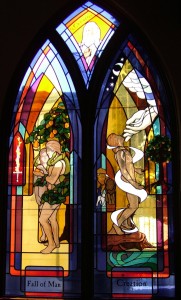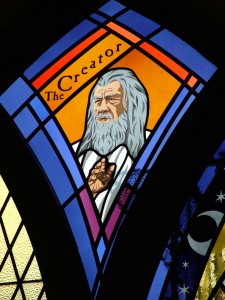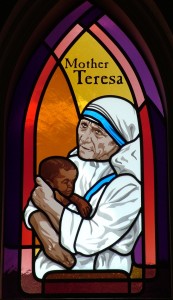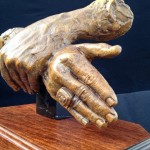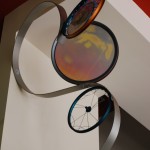Saint Louis Catholic Church- Englewood, Colorado

About the Stained Glass
The stained glass windows at Saint Louis Catholic Church in Englewood, Colorado were made with German and French antique glass. “Antique” refers to the centuries old mouth blown process in which they were made. Because of their hand-crafted nature, antique glasses have a richer color palette and many more beautiful random elements found in them than machine-made glasses.
Check out a video of antique glass blowing here.
The individual pieces of colored glass were cut out of the antique glass sheets and are held together with lead came which has been soldered at the joints. A cement was then pushed between the lead came and glass pieces to stabilize and weatherproof the windows.
All of these materials and steps are essentially the same as those that have been used for around 1,000 years in the creation of religious stained glass.
Special Glass Techniques
Another ancient technique, used for most of the detailed features found in the windows, is glass painting, or “staining”. Special paint recipes are applied and fired into the glass, often multiple times, to achieve fine, permanent, design detail. True “stained glass” is only that which contains elements that have been stained and fired.
There are a few instances of another special technique to be found in the windows. Etched glass has only been around since the late 1800’s but has been widely used in the finest stained glass windows ever since. In places you can see where the surface of the glass pieces have been etched for detail. In other areas etching has gone deeper into the glass to completely or partially remove the surface color of the “flash” glass. Most antique glass has the color all the way through it. Flash glass has at least one color thinly “flashed” onto the surface when it is made.
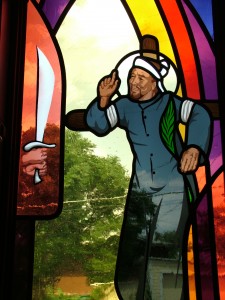
Stained and Etched Glass Example
Design Concepts
The line style found in the background of the stained glass windows is an extension of the architectural elements found in the church. The most prominent linear elements being the curves of the Gothic arched window openings.
The colors used in the windows are primarily the same as those found in older, traditional style, stained glass windows. This palette is in keeping with the overall style of the church.
One of the original purposes of stained glass windows was an educational one. Many, if not most, worshipers in Medieval times were illiterate. The windows were a useful visual tool to teach them about the Bible and Life of Christ. The design style of the imagery in the stained glass at St. Louis speaks to this tradition. This is especially appropriate with the parish school being such an integral part of the life of the church.
Themes Found in the Stained Glass Windows
There are sixty three stained glass windows at St. Louis Church. Sixty-one each have their own theme. Two entrance door windows combine to form a single theme- the Presence of Christ in our daily lives.
Six Nave Sets
The six nave window sets hold twelve History of Salvation scenes and six depictions of key figures from the Old Testament.
Creation
This set of panels represents the beginning of humanity. In the right panel we see “Creation,” in which God is forming the world and giving man with his benevolent touch. In the left panel we see the “Fall of Man.” Adam and Eve are about to succumb to temptation. Above these two scenes we see God the Father/Creator.
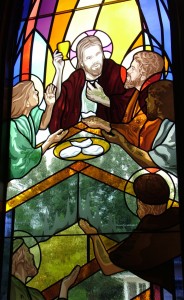
The Last Supper
This window depicts The Last Supper- the last meal Jesus shared with his Apostles before being crucified. This meal is the origin of The Holy Communion. Notice how the trees behind the glass blend seamlessly into the window.
The Transcepts, Clerestory, and CryRoom
These areas are all dedicated to specific sainted or beatified persons.
Mother Teresa
During her lifetime, Mother Teresa founded the Missionaries of Charity, a congregation which runs hospices and homes for any person in need. Through her work and the work of those who followed her, countless lives have been changed for the better.
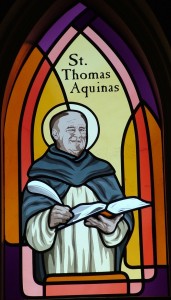
Saint Thomas Aquinas
Aquinas is the patron saint of all students and universities. He is known as one of the greatest theologians, and was a prolific writer and instructor. His influence earned him the title of “Doctor of the Church.”
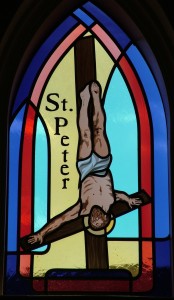
Saint Peter
First of the Apostles, Saint Peter was the first pope. As is shown in the stained glass, Peter asked that he be crucified upside-down because he didn’t believe he deserved to die in the same position as the Lord.
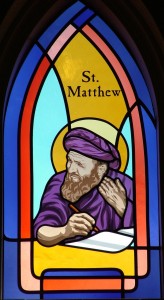
Saint Matthew
Matthew was another of Jesus’ Apostles. He wrote the first Gospel, in which he encouraged those who follow the Lord to remain vigilant in their trials, and those who don’t follow the Lord to believe in the truth behind the teachings of Jesus.
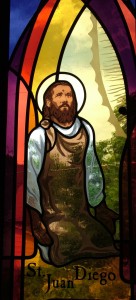
Saint Juan Diego
The Virgin Mary appeared to Saint Juan Diego on a hilltop near what is now Mexico City. She told him to build a church at the site which he accomplished by proving his meeting to the local bishop with flowers that had sprouted in the frozen ground and an image of the Virgin Mary on his cloak. His work helped to drastically improve the presence of the Church in Mexico.
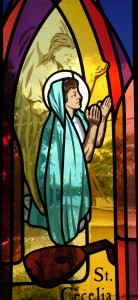
Saint Cecelia
Known as the patroness of music, Saint Cecelia was watched over by an angel (depicted in the stained glass). When she was sentenced to death, she could not be killed with the heat of fire, so an axe was taken to her neck which still could not kill her. She lived for 3 more days, comforting and preaching to those who visited her to the very end.
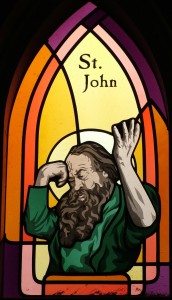
Saint John
Author of the fourth Gospel and possibly the Book of Revelations, Saint John is known as the Apostle of Charity. He was the last of the twelve Apostles to die, and the only of the twelve to stand by the cross during the crucifixion of Jesus, earning him the title of the “beloved disciple.”
The Chancel
The chancel has two windows with the themes of the Sacraments of The Eucharist (with St. Tarcisius) and Baptism.
West Wall
The rose window depicts The Ascension of Jesus. The windows on each side of the Rose window show the Archangels Michael and Gabriel.

